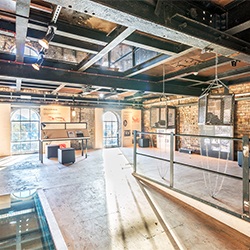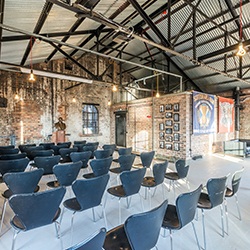The National Mining Memorial Centre at the National Mining Museum Scotland is located just nine miles from Edinburgh at the Lady Victoria Colliery, Newtongrange.
Lady Victoria Colliery
The Lady Victoria Colliery opened in 1895 and was one of Scotland’s first super-pits. At its peak, the colliery employed approximately 2,000 people and over the course of its lifetime, it reportedly produced a record 36 million tonnes of coal. The mine closed in 1981 and the museum was established in 1984 to preserve its remaining buildings. To this day, it remains one of the best preserved Victorian collieries in Europe.
Re-washer Building
The 1930s building, which had lain empty for over 30 years, has been given new purpose with memorial, exhibition and storytelling spaces. Known as the re-washer, this four storey brick extension was added in 1932 to treat coal dross from the adjoining washer. This building is now the last stop on the museum’s tour through the history of coal.

Working within the restrictions of its listed status, Purcell’s design approach was purposefully restrained to allow the industrial patina to remain and so that visitors can easily understand the former use of the space. Three floors provide new exhibition and education spaces. The first and second floors contain library and research facilities as well as a storytelling area. A two-storey void was retained and enhanced between these floors to accommodate a display of health and safety objects which are artfully suspended in metal cages. The top floor is a secular memorial space that features a black memorial table formed from coal. This floor also enables the museum to host events and temporary exhibitions.
The £130,000 refurbishment work was undertaken by John Dennis Construction, structural engineers Elliot and Company and quantity surveyors, Thomson Gray.

Senior Architect, Scott Lindsay said: “The Memorial Centre is a fitting tribute to Scotland’s mining past and has reinstated a category A listed building that has stood empty for 30 years. Our design complements the industrial character of this brick building, creating new display and archive areas which explore the dangers faced by miners, leading up to a tall reflective space in the roof.”
Museum Director, Rowan Brown said: “The Friends, staff and volunteers at National Mining Museum Scotland had long held aspirations to create a facility that commemorated an industry which changed our culture, landscape and economy at immense personal cost. We owe a huge debt to our funders, without whose generous support, the project could not have been realised. It was with great pride that we opened the National Memorial Centre, a resource dedicated to serving our mining communities, past, present and future.”
Midlothian MP, David Hamilton opened the centre on 7th September 2013, the anniversary of the Knockshinnoch Castle Colliery disaster, one of the most significant in Scottish mining history. The National Mining Memorial Centre is open from 10am until 5pm (4pm in winter), seven days a week.
The results of the EAA Awards will be announced on 1st April 2014. The RIAS Awards winners will be announced on 18th June.
Back to top




